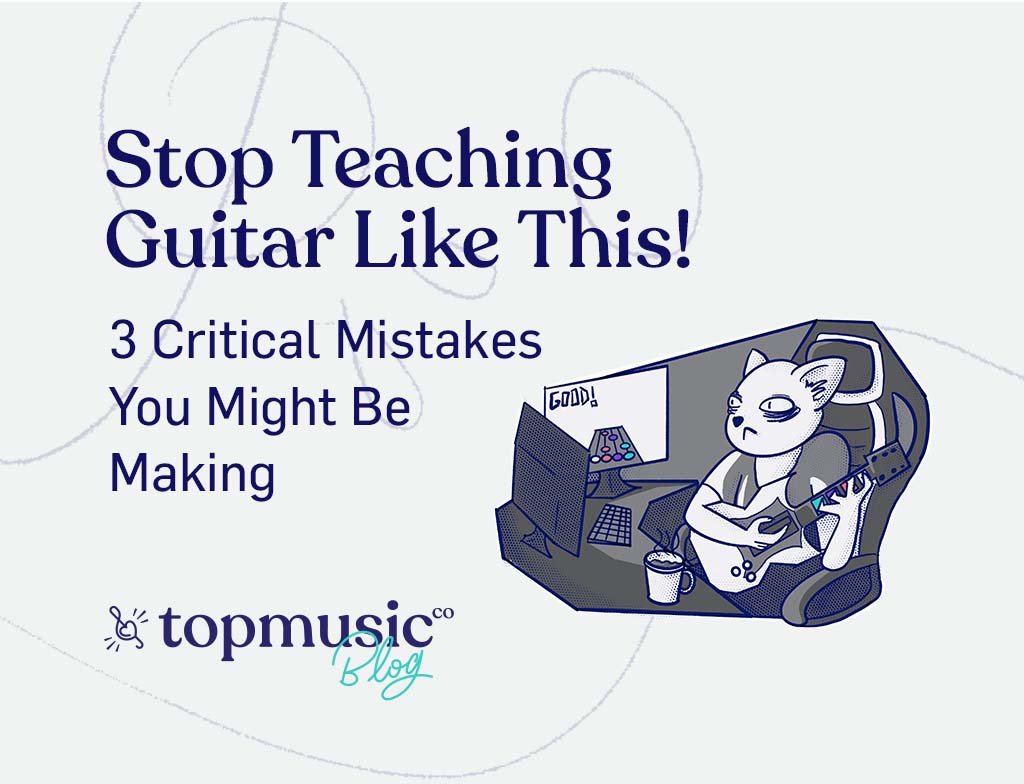Are you doing any of these 3 lesson deal-breakers?

Are you struggling to keep your guitar students interested and engaged during your lessons? What about retention — is it tough keeping students in lessons beyond the first few ‘try it out’ months? How about the frustration of seeing students turn up who never practice or make any progress?
If so, you might be keen to learn how to maneuver around some of these issues. We’ll take a look in this article at 3 critical mistakes commonly made in teaching guitar, and how to course-correct. These changes really improve students’ motivation and prevent them from losing interest when they’ve just started, and head off premature quitting.
Hopefully, at the end of this article, you will have a greater awareness of the different types of students and many of the mistakes that we make (usually unintentionally) that often cause them to quit without us ever knowing that there was a problem.
Many of us teachers struggle with managing student motivation. If you’re there – you’re not alone. We sometimes can’t understand why our students don’t have the same level of enthusiasm as we had for lessons when we first started playing!
Guitar was such a wondrous discovery for many of us! Remember feeling instantly hooked? You felt an instant connection with your instrument, and it probably has continued on through this day.
Thing is, many students don’t automatically have this experience. Some develop it along the journey. Happily, in many occasions, we teachers can be directly responsible for igniting that passion in our students.
But we will teach many different kinds of students who are learning guitar for various reasons. It’s essential to understand that not every student can be taught the same way. Only a small number will have professional ambitions like we once did.
Learning to read music is one of the most important skills a professional musician can develop, and I encourage all guitar players to learn.
However, learning how to sight-read in the beginning is one of the worst things you can do for a student.
When first learning guitar, the student has to go through the complex process of learning how to coordinate their left hand performing one movement and their right hand doing another movement, all while trying to read or remember the music and somehow keep it all in time.
This is already difficult enough without having them try to remember which dot on which line or space means to play, which fret for how many counts they learned only a few minutes earlier and haven’t yet been able to consolidate into their long term memory.
If you’ve ever learned how to drive a manual car and can remember back to your first day (which was probably a traumatic experience), you know exactly how hard it is to try and coordinate three things at once and how overwhelming it can be.
This is what it’s like for beginner students when you’re trying to teach them how to read musical notation in their first couple of lessons.
Another challenge is guitar method books commonly begin with a sight-reading approach. They tend to use classical tunes or tepid folk songs, which students aren’t too fired up to learn.
Wouldn’t it be better if your students learned how to play their favourite rock guitar riffs from the first lesson? Then in a couple of months, once they have developed better finger dexterity and coordination and a better understanding of the fretboard, you can teach them how to sight-read. It will be a much easier and faster process because their fingers already work.
Solution: Save yourself a headache (and potentially the students whole music career) and start with guitar tabs. Then, come back to standard notation when the students are more capable and confident in a few months.
Many students will teach themselves songs on the internet using YouTube. They will come across Marty or Justin giving them an ‘easy beginner guitar lesson’ on a song featuring bar chords.
The teacher in the video will say something along the lines of “This song normally uses bar chords, so we’ve made a simplified version using open chords.’
The problem is that most open chords aren’t simple at all because they require the student to coordinate two or three fingers at a time between very different shapes, which is virtually impossible to develop the coordination for in less than a few months.
This ensures that enthusiastic students instantly have their motivation snuffed out because they can’t play the ‘easy’ version of the song and quickly leads to self-doubt and a lack of confidence in their ability to play the guitar.
It’s not that they don’t have what it takes. It’s because they’ve been thrown in the deep end with difficult chords by a teacher who forgot how hard guitar was in the beginning.
The reality is that while open chords are generally the first chords we learn, they are hard for most beginners and aren’t the first chords we should be learning.
Related: Find our membership-level courses and cheatsheets for guitar teachers in TopMusicGuitar.
Many teachers aren’t aware that you can make simpler versions of your chords.
I guarantee you that you can get students playing along to ANY chord-based song using just power chords or even root position three-string triad shapes in the first lesson or two and still have it sound a lot like the actual song. So while it might seem simple to you (or even have you saying “that’s cheating!“), it will be more than enough to have your students grinning ear to ear and instilled with a newfound sense of belief in their ability to play the guitar.

Solution: Instead of throwing your students into the deep end with bar chords or open chords, ask yourself, “what is the easiest next step I can have my students do” and more often than not, it’s ten times simpler than what you’d traditionally have had them do.
Drawing from longstanding music teaching traditions, a lot of us teach the way that we ourselves were taught. We use certain method books or have an approach we believe in that feels like “the right way.” We don’t like to deviate from that approach because that is how we have learned, and it’s comfortable for us.
Unfortunately, traditional methods are just entirely out of touch with younger generations of students. With the advent of Snapchat, iPads and other technologies, people’s attention spans are shorter than ever. Add to this the difficulty that most people are gratification junkies and don’t self-discipline towards long term work as easily now.
Students want to learn music that they like, they want it to be easy, and they want immediate results.
If you’re teaching sight-reading, learning strings one at a time, and focussing on your favourite tunes from the ’60s as study pieces, then prepare for a massive turnover of students.

For one, it helps if you get to know your students!. Go ahead and take the time to set musical and guitar playing goals with them – they’ll love the process. Then create a lesson plan that is relevant to their goals and teach them what they need in the context of what they want.
Focus on making lessons fun, easy and enjoyable for your students and nurture them through the beginner phase.
When they get more accomplished, then you can come back and teach more music theory or introduce them to the more complex jazz improvisation topics if that’s what you enjoy, but only do this once you’ve piqued their interest and have gotten them to the level where they are ready for it.
Disclaimer/Throwing Tomatoes Alert: Now I realise that some of the points above will be a touchy subject for many people reading this. I am totally not discounting the value of sight-reading, learning music theory or following a structured method.
Instead, I am advocating that you need to make lessons fun and relevant to students as a first priority because if the student quits lessons because they didn’t enjoy their time with you, they’ll never stick with it long enough to develop into long term musicians and get to the point where they can work on their reading and theory.
Just like you learn to talk before you learn to read, you can teach students how to play and make music long before they need to read the notes or understand the theory. Then once you’ve got them hooked, come back and teach the serious ones more in-depth theory and musicianship skills.
It’s all about the order.
Teach the right thing in the correct order at the proper time, and your students will excel in confidence and become fantastic guitar players.
Teach them the right thing in the wrong order, and people who could become lifelong players may quit before ever giving it a fair chance.
I reflected upon this point the other day: A strict piano teacher might think himself successful because he’s trained ten concert pianists using his method over the last two decades.
But if he made the other 990 students quit lessons because he was too strict and made the lesson too dull, was he a successful teacher? The majority of these students (and most of your students) will never be superstars or career musicians. Still, they might be life-long hobby players who gain decades of enjoyment and fulfilment from learning how to play their instrument.
What is more important to you, training a dozen professional musicians every decade? Or could it be helping hundreds of people discover a lifelong sense of fulfilment by learning guitar?
So what’s the final answer? Admittedly none of us has arrived as teachers – we all can improve our craft each time we sit down with a student. By adapting your learning style to each person in front of you, you can teach the fun and then work in the fundamentals!
Download your FREE ebook How to Teach Blues Guitar in 5 Easy Steps and have students sound great playing blues at every level. Use these easy steps to build skills while you have a ton of fun with your students right away.
